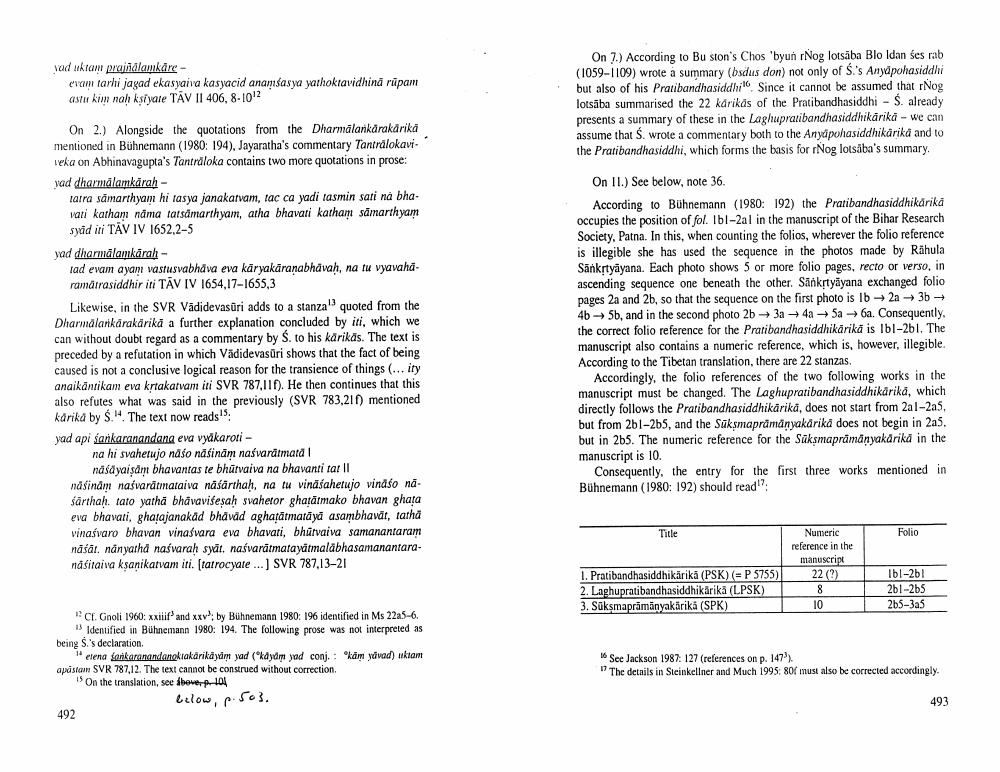Book Title: On Dates And Works Of Sankaranandana Author(s): Helmut Krasser Publisher: Helmut Krasser View full book textPage 3
________________ vad uktam prajñālamkare - evam tarhi jagad ekasyaiva kasyacid anamıśasya yathoktavidhinā rūpam astu kim naḥ kṣiyate TAV II 406, 8-1012 On 2.) Alongside the quotations from the Dharmälankärakärikä mentioned in Bühnemann (1980: 194), Jayaratha's commentary Tantralokaviveka on Abhinavagupta's Tantraloka contains two more quotations in prose: yad dharmalamkarah tatra samarthyam hi tasya janakatvam, tac ca yadi tasmin sati na bhavati katham nama tatsämarthyam, atha bhavati katham samarthyam syad iti TAV IV 1652,2-5 yad dharmālamkarah tad evam ayam vastusvabhāva eva kāryakāraṇabhāvaḥ, na tu vyavahāramätrasiddhir iti TĀV IV 1654,17-1655,3 Likewise, in the SVR Vadidevasūri adds to a stanza13 quoted from the Dharmälankärakärikä a further explanation concluded by iti, which we can without doubt regard as a commentary by S. to his kärikäs. The text is preceded by a refutation in which Vädidevasüri shows that the fact of being caused is not a conclusive logical reason for the transience of things (... ity anaikantikam eva kṛtakatvam iti SVR 787,11f). He then continues that this also refutes what was said in the previously (SVR 783,21f) mentioned karika by $14. The text now reads15: yad api sankaranandana eva vyakaroti - na hi svahetujo našo nāšinām naśvarāmatā | näsäyaiṣām bhavantas te bhutvaiva na bhavanti tat || nasinăm naśvarātmataiva nāsārthah, na tu vindahetujo vina sonaśärthaḥ. tato yatha bhavaviseṣaḥ svahetor ghatatmako bhavan ghata eva bhavati, ghatajanakad bhävad aghaṭātmatāyā asambhavät, tatha vinaśvaro bhavan vinaśvara eva bhavati, bhūtvaiva samanantaram nāśāt. nanyatha naśvaraḥ syat. naśvarätmatayatmaläbhasamanantaranāsitaiva kṣaṇikatvam iti. [tatrocyate ...] SVR 787,13-21 Cf. Gnoli 1960: xxiiif3 and xxv3; by Bühnemann 1980: 196 identified in Ms 22a5-6. Identified in Bühnemann 1980: 194. The following prose was not interpreted as being S.'s declaration. elena tankaranandanokiakärikāyām yad ("kāyām yad conj. "kām yavad) uktam apāstam SVR 787,12. The text cannot be construed without correction. 15 On the translation, see above, p-101 492 below, p. 503. On 7.) According to Bu ston's Chos 'byun rNog lotsaba Blo Idan ses rab (1059-1109) wrote a summary (bsdus don) not only of S.'s Anyapohasiddhi but also of his Pratibandhasiddhi. Since it cannot be assumed that rNog lotsāba summarised the 22 kärikäs of the Pratibandhasiddhi - Ś. already presents a summary of these in the Laghupraibandhasiddhikarika - we can assume that Ś. wrote a commentary both to the Anyapohasiddhikarika and to the Pratibandhasiddhi, which forms the basis for rNog lotsäba's summary. On II.) See below, note 36. According to Bühnemann (1980: 192) the Pratibandhasiddhikarikā occupies the position of fol. 1b1-2al in the manuscript of the Bihar Research Society, Patna. In this, when counting the folios, wherever the folio reference is illegible she has used the sequence in the photos made by Rähula Sänkṛtyayana. Each photo shows 5 or more folio pages, recto or verso, in ascending sequence one beneath the other. Sänkṛtyäyana exchanged folio pages 2a and 2b, so that the sequence on the first photo is Ib2a3b→ 4b5b, and in the second photo 2b3a 4a5a6a. Consequently, the correct folio reference for the Pratibandhasiddhikarika is Ibl-2b1. The manuscript also contains a numeric reference, which is, however, illegible. According to the Tibetan translation, there are 22 stanzas. Accordingly, the folio references of the two following works in the manuscript must be changed. The Laghupratibandhasiddhikarika, which directly follows the Pratibandhasiddhikarika, does not start from 2a1-2a5, but from 2b1-2b5, and the Sükṣmapramäṇyakärikä does not begin in 2a5. but in 2b5. The numeric reference for the Sükṣmapramäṇyakärikä in the manuscript is 10. Consequently, the entry for the first three works mentioned in Bühnemann (1980: 192) should read17: Title 1. Pratibandhasiddhikärikä (PSK) (= P 5755) 2. Laghupratibandhasiddhikärikä (LPSK) 3. Sükṣmaprāmānyakärikä (SPK) Numeric reference in the manuscript 22 (2) 8 10 Folio Ibl-2b1 2b1-2b5 2b5-3a5 16 See Jackson 1987: 127 (references on p. 1473). The details in Steinkellner and Much 1995: 80 must also be corrected accordingly. 493Page Navigation
1 2 3 4 5 6 7 8 9 10 11
